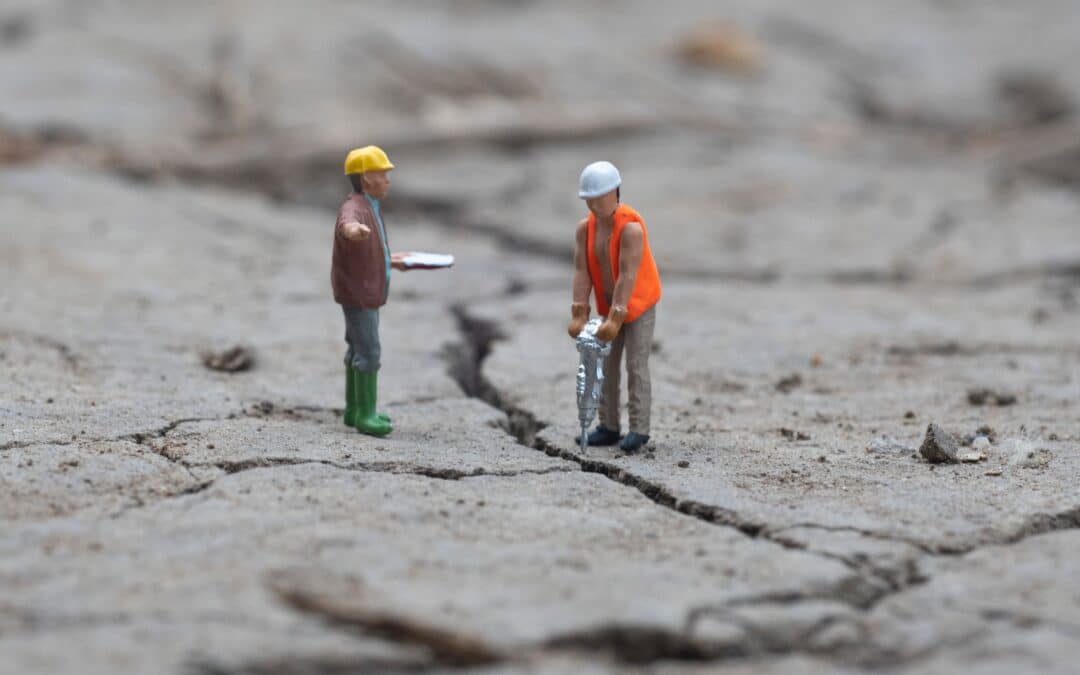Concrete slab settlement often occurs due to the movement or instability of the soil beneath it. This instability can lead to concrete settlement, a common issue in both residential and commercial properties. One of the most visible signs of this problem is sunken concrete, where parts of the slab appear lower than the surrounding area.
Sunken concrete slabs: Soil quality & erosion
Soil erosion is often the primary cause when it comes to uneven concrete. Erosion in existing concrete can occur due to water flow beneath the slab, which washes away the soil, leaving voids. When these voids become too large to support the weight of the slab, it begins to crack and settle.
Another factor contributing to concrete settling is the nature of the soil itself. Some soils are prone to expansion and contraction due to moisture and temperature changes, which can cause uneven support for the concrete above.
Concrete levelling
The solution to these issues is often leveling the concrete, which is done to raise and stabilize the slab. Concrete levelling is a less invasive and more cost-effective alternative to complete slab replacement. The process usually involves drilling small holes into the sunken slab and then injecting a leveling material, such as polyurethane foam or a cementitious mixture, beneath it. This material fills the voids and raises the slab back to its original level.
With proper techniques like concrete leveling, it’s possible to effectively fix sunken concrete slabs and prevent further concrete settling, ensuring a stable and even surface.
Concrete slabs: Poor compaction
There are other aspects to consider when dealing with settling concrete. Cement slabs and concrete slabs can also experience settlement issues. One common cause is poorly compacted fill soil. When the soil foundation beneath the slab isn’t compacted properly during the construction phase, it can lead to uneven concrete or uneven cement surfaces over time. This is because fill soil that isn’t dense enough will compress under the weight of the cement slabs, causing them to sink or settle unevenly.
The impact of water leaks in drainage systems plays a role as well. Water from these leaks can wash away or weaken the soil foundation, leading to settled concrete. This is a particular concern as concrete settles over areas where underground plumbing is present and may be leaking. The constant flow of water can erode the soil, creating voids and leading to instability.
A comprehensive approach for concrete settlement
For uneven concrete caused by poorly compacted soil, re-compaction or the addition of more stable fill materials might be necessary. In cases where plumbing leaks contribute to settling concrete, repairing the leaks is an essential first step before any concrete leveling or repair is done.
The stability of cement slabs and concrete surfaces is heavily dependent on the condition of the soil underneath. Ensuring that the soil foundation is stable, compact, and free from factors like erosion and water damage is key to preventing concrete settlement. Regular inspection and maintenance can help identify potential problems early, preventing more significant and costly repairs in the future.
Concrete slab subgrade repair: Deep foam injection
Our expertise for concrete slab repair includes deep foam injection, a state-of-the-art solution for lifting concrete and stabilizing soils. This method involves injecting high-density foam deep into the soil, which expands and hardens, providing a solid support to the slab above.
We also provide void fill services to tackle the issue of voids created by soil erosion or compaction problems. These services ensure that your concrete remains level and stable. Contact us for a free consultation!

